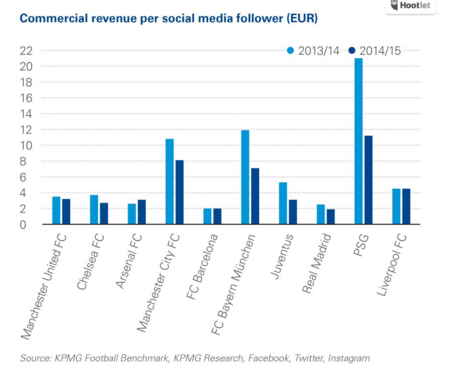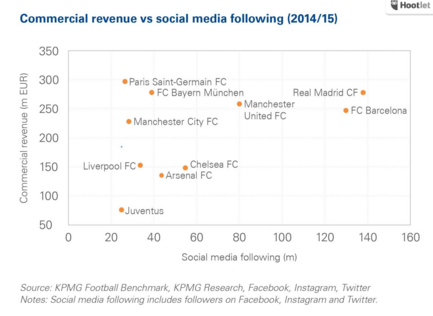By Paul Nicholson
October 6 – Social media is the fastest growing segment of most clubs’ activities but can the followers be monetised directly or are they part of the larger media/sponsor sale metrics? It is an issue that is increasingly flexing club thinking as they look to maximise and get a return on their investments in the social arena.
KPMG’s Football Benchmark analysts have looked at the correlation between the most popular clubs’ social media followers (Facebook, Instagram and Twitter) and their commercial revenues.
“Since September 2014, the combined social media followers of the Top 10 most popular clubs across Facebook, Instagram and Twitter has jumped by 70%, demonstrating the important role of social media platforms connecting sports entities with their global audiences. A key contributor to this growth has been Instagram, where the combined level of attention on these clubs increased from less than 16m in September 2014 to 132m last month,” says Football Benchmark.
They find that there is a correlation between the growth in club revenue to the growth in social media, with most of Europe’s big clubs “undoubtedly profit(ing) from gaining global followers by generating higher commercial revenues than domestic rivals with more of a local fan base.”
They cite Barcelona as an example of this. “FC Barcelona in the 2014/15 season, replicated its on-pitch success (Champions League title) off the pitch, recording a 34% increase in commercial revenues (EUR 207m to EUR 278m) and 31% growth in social media followers (105m to 138m).”
While the observation generally works as a good rule of thumb, it doesn’t carry through into a bankable economic ‘law’. “FC Bayern München, Juventus FC and Paris Saint-Germain are the only clubs under review that reported a drop in commercial revenues between the 2013/14 and 2014/15 season,” says the report. Social media may in fact be a measure of popularity and consumer preference rather than a stable measure of revenue performance. Though it certainly can point towards revenue potential.
Looking at commercial income per follower Football Benchmark find that “with the exception of FC Barcelona, Liverpool FC and Arsenal FC, and despite the general increase in commercial revenue, the clubs’ per follower value saw a net decrease from 2013/14 to 2014/15, suggesting that higher commercial gains do not automatically follow social media base gains.”
Football Benchmark says: “It is especially interesting to note how clubs lower in the ranking, both in terms of followers and commercial revenues, such as Juventus FC and Liverpool FC, recorded a considerably higher commercial revenue per follower than those at the top, in particular FC Barcelona and Real Madrid. However, rather than stressing differences between the business operations of these clubs, this contrast seems to highlight that the monetization of social media followers by a football club has a long way to develop yet.
So what should be the business objective of driving social media numbers upwards and should it be measured on a revenue per follower basis? So far it is hard to come to a definitive conclusion as the market is clearly expanding in terms of technology and club understanding of how to use it.
One conclusion that Football Benchmark does reach is: “As clubs focus their efforts on driving fans from social media to their own platforms, those able to harness the potential of their global brand in the digital space are likely to develop a competitive advantage in the coming seasons.”
See the full report at https://www.footballbenchmark.com/football_clubs_monetize_social_media
Contact the writer of this story at moc.l1713968461labto1713968461ofdlr1713968461owedi1713968461sni@n1713968461osloh1713968461cin.l1713968461uap1713968461



